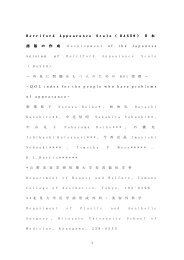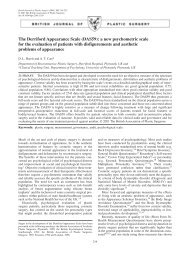DAS-59 - Derriford Appearance Scales
DAS-59 - Derriford Appearance Scales
DAS-59 - Derriford Appearance Scales
You also want an ePaper? Increase the reach of your titles
YUMPU automatically turns print PDFs into web optimized ePapers that Google loves.
202<br />
Tony Carr et al.<br />
(Berscheid, 1981). <strong>Appearance</strong> communicates information about ethnicity, character, and<br />
physical and emotional states. Disgurements caused by congenital malformations,<br />
disease and its treatment, trauma and burns put visibly different people at a social<br />
disadvantage with a risk of social and interpersonal difculties, stigmatization and<br />
isolation (Rumsey, 1997). Clinical experience indicates that even apparently minor<br />
problems of appearance such as skin blemishes, obesity, disproportional growth of<br />
features and the effects of child-bearing or ageing can generate severe distress and<br />
behavioural dysfunction in many people.<br />
In view of the social importance of appearance, there has been little attention hitherto<br />
to the denition, assessment and understanding of problems of appearance or to their<br />
physical or psychological treatment. For surgical interventions, evidence of benet has<br />
been largely anecdotal or inferred from pre- and post-operative photographs. Recent<br />
reviews of approaches to assessment in disgurement (Carr, 1997a, 1997b) have revealed<br />
a dearth of relevant psychometric scales. Studies which have used psychometric assessments<br />
have relied principally upon existing measures of mental health status, personality<br />
or quality of life, and there has been only a very limited, and recent, choice of measures<br />
which focus on problems of appearance (e.g. the <strong>Appearance</strong> Schemas Inventory (ASI;<br />
Cash & Labarge, 1996); the Multidimensional Body-Self Relations Questionnaire<br />
(MBSRQ; Brown, Cash, & Mikulka, 1990); the Body Image Avoidance Questionnaire<br />
(BIAQ; Rosen, Srebnik, Saltzburg, & Wendt, 1991) and the Body Dysmorphic Disorder<br />
Examination (BDDE; Rosen, Reiter, & Osoran, 1995)).<br />
Of these more relevant measures, the ASI is focused upon the meaning and importance<br />
of appearance and is standardized only on female college students. The BDDE requires an<br />
extensive structured interview with the respondent which renders it largely impractical<br />
for most applications. The MBSRQ is a set of 11 short scales including measures of<br />
appearance satisfaction, feelings of attractiveness and interest in appearance. Other scales<br />
of much less relevance to appearance are included (e.g. attitudes to health and tness), and<br />
there has been only limited investigation of the psychometric properties of the various<br />
scales (Brown, Cash, & Mikulka, 1995). Essentially the MBSRQ is a broad measure of<br />
interest and satisfaction with one’s body, including appearance. It does not represent the<br />
concerns of a clinical sample and provides no index of behavioural and social dysfunction<br />
and distress associated with problems of appearance. The BIAQ was designed to extend<br />
the assessment of body-image disturbance to include ‘an extensive assessment of the<br />
avoidance behaviours and grooming habits that are associated with negative body-image’<br />
(Rosen et al., 1991, p. 33). The scale shows good validity and reliablity and a stable fourfactor<br />
structure. However, standardization is limited almost wholly to young, female<br />
students and the item content is similarly dominated by the concerns of that population<br />
(i.e. weight and body-size). The authors acknowledge the limitation of a self-report scale<br />
as an assessment of behaviour, but report a good correlation (.72) between scores on the<br />
scale and peer ratings of respondents’ behaviours and concerns. The scale has clear utility<br />
in the eld of eating disorders and with young, female samples, but it is correspondingly<br />
of limited application to problems of appearance unrelated to weight and body-size to<br />
males, or to samples of wider age-range and socio-economic status.<br />
Overall, existing measures suffer from low content validity, impracticability and<br />
limited psychometric development. Inevitably, this has restricted our understanding of<br />
the emotional and behavioural issues associated with problems of appearance. Similarly,





